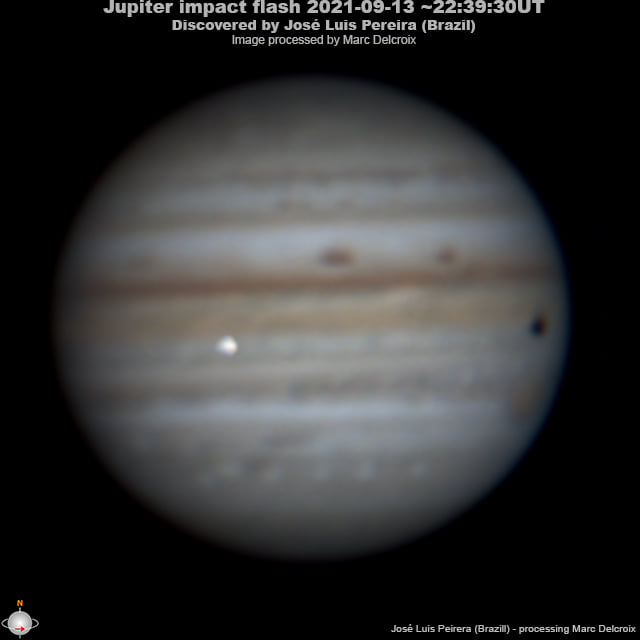
Jupiter got whacked again.
Brazilian observer José Luis Pereira captured a bright flash on the solar system's largest planet Monday night (Sept. 13), memorializing the fiery death of a space rock high in the Jovian atmosphere.
"I am an assiduous planetary observer," Pereira told Space.com in a written statement Tuesday (Sept. 14). "When the planets Jupiter, Saturn and Mars are in opposition, I try to make images in every possible night of clear skies. Especially [of] the planet Jupiter, my favorite."
Related: Juno spacecraft's amazing views of Jupiter (photos)
More: The best telescopes of 2021 for beginners and viewing planets
On Sunday (Sept. 12) and Monday, Pereira set up his equipment in São Caetano do Sul, in the southeastern Brazilian state of São Paulo. As on many other nights, he aimed to photograph Jupiter and capture videos for the DeTeCt program, which seeks to spot and characterize impacts on the giant planet.
The weather didn't look like it would cooperate on Monday night, but Pereira persevered, collecting a series of 25 Jupiter videos, with no time gap between them.
"To my surprise, in the first video I noticed a different glow on the planet, but I didn't pay much attention to it as I thought it might be something related to the parameters adopted, and I continued watching normally," Pereira wrote. "So as not to stop the captures in progress for fear that weather conditions would worsen, I didn't check the first video."
Get the Space.com Newsletter
Breaking space news, the latest updates on rocket launches, skywatching events and more!
He fed the videos into the DeTeCt program and then went to bed.
"I checked the result only on the morning of the 14th, when the program alerted me to the high probability of impact and verified that there was indeed a record in the first video of the night," Pereira wrote.
He then sent the information to Marc Delcroix of the French Astronomical Society, who confirmed that Pereira had indeed recorded footage of an impact that occurred Monday at 6:39 p.m. EDT (2239 GMT).
"For me it was a moment of great emotion, as I have been looking for a record of [such an] event for many years," Pereira wrote.
His observing setup consists of the following, he added: a Newtonian Telescope 275mm f/5,3 with a QHY5III462C camera, plus a Televue Powermate 5x (f/26,5) eyepiece and an IRUV cut filter. If you're looking to learn more about how to photograph planets, check out our astrophotography for beginners guide for the basics. You can also see how the Nikon Z6 camera stacks up for astrophotography here.
You can see more of Pereira's astronomical work on Flickr and YouTube.
A big, frequently battered planet
Because it orbits close to the main asteroid belt and features a powerful gravitational pull, Jupiter gets pummeled fairly often. In July 1994, for example, fragments of the broken-apart Comet Shoemaker-Levy 9 famously slammed into Jupiter, creating big bruises in the planet's thick atmosphere that lasted for months.
Those scars opened a rare window into Jupiter below the cloud tops, and professional astronomers took advantage of the opportunity. They studied the impact sites with a variety of powerful telescopes, fleshing out our understanding of the gas giant's atmospheric composition.
Another high-profile smashup occurred 15 years later, when an impactor punched a scar the size of the Pacific Ocean into Jupiter's swirling air. Like the Shoemaker-Levy 9 lesions, that blemish lingered long enough for professional astronomers to mobilize.
But it doesn't look like they'll get that chance with the newly observed impact.
"The site is clearly resolved and no visible scar was left (just as with previous impact flash events.) The object was probably too small to reach the deeper atmosphere," astrophotographer Damian Peach wrote on Twitter Wednesday, where he posted a gorgeous photo of a healed-up Jupiter taken an hour after it was hit.
Mike Wall is the author of "Out There" (Grand Central Publishing, 2018; illustrated by Karl Tate), a book about the search for alien life. Follow him on Twitter @michaeldwall. Follow us on Twitter @Spacedotcom or Facebook.
Join our Space Forums to keep talking space on the latest missions, night sky and more! And if you have a news tip, correction or comment, let us know at: community@space.com.

Michael Wall is a Senior Space Writer with Space.com and joined the team in 2010. He primarily covers exoplanets, spaceflight and military space, but has been known to dabble in the space art beat. His book about the search for alien life, "Out There," was published on Nov. 13, 2018. Before becoming a science writer, Michael worked as a herpetologist and wildlife biologist. He has a Ph.D. in evolutionary biology from the University of Sydney, Australia, a bachelor's degree from the University of Arizona, and a graduate certificate in science writing from the University of California, Santa Cruz. To find out what his latest project is, you can follow Michael on Twitter.









